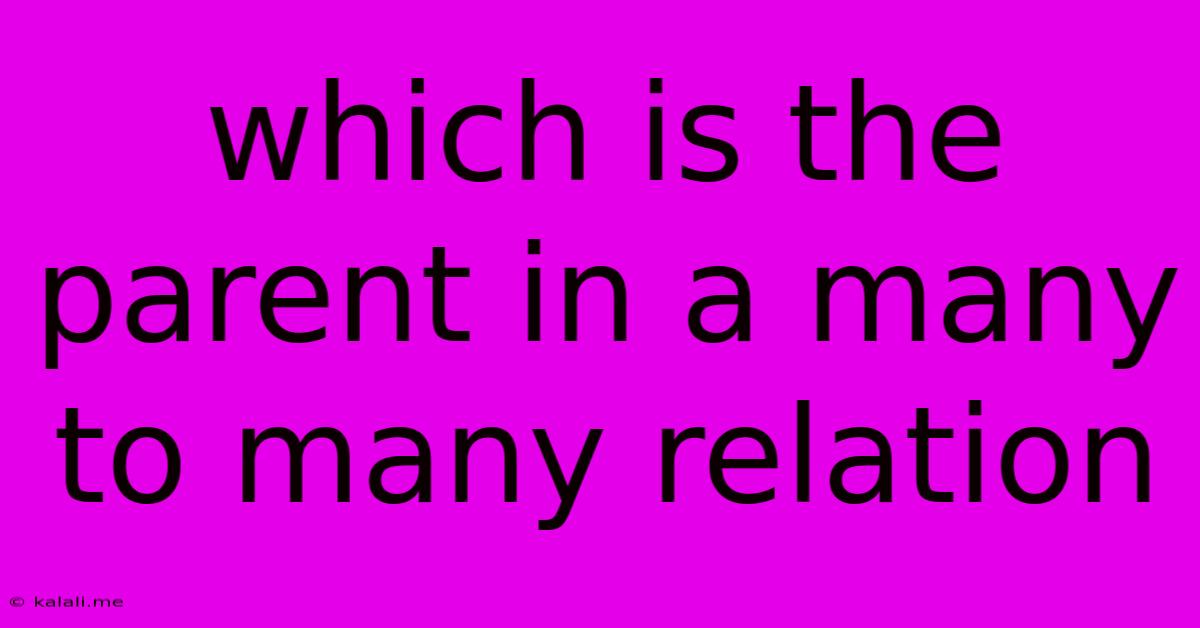Which Is The Parent In A Many To Many Relation
Kalali
Jun 04, 2025 · 3 min read

Table of Contents
Which is the Parent in a Many-to-Many Relationship? There's No Single Answer!
Many-to-many relationships are a fundamental concept in database design, but the question of which entity is the "parent" often causes confusion. The truth is, there isn't a parent in a many-to-many relationship in the traditional sense. Unlike one-to-many relationships where a clear parent-child hierarchy exists, many-to-many relationships represent a more symmetrical connection between two entities.
This article will clarify the misconception of parenthood in many-to-many relationships and explore the best practices for modeling and implementing them in your database.
Understanding Many-to-Many Relationships
A many-to-many relationship exists when one record in a table can be associated with multiple records in another table, and vice versa. A classic example is the relationship between students and courses: one student can take multiple courses, and one course can be taken by multiple students.
There's no inherent hierarchical structure here. A student doesn't "own" a course, nor does a course "own" a student. They have a mutual, equal association.
The Role of the Junction Table (or Bridge Table)
To effectively model a many-to-many relationship in a relational database, you need a junction table (also known as an associative table or bridge table). This intermediary table acts as the glue, connecting the two main entities.
Let's use the student-course example:
- Students Table:
student_id,student_name - Courses Table:
course_id,course_name - Enrollments Table (Junction Table):
student_id,course_id
The Enrollments table holds the foreign keys (student_id and course_id) linking a student to the courses they're enrolled in. Each row in this table represents a single enrollment instance.
This three-table structure is crucial because it eliminates the ambiguity and accurately represents the many-to-many relationship.
Why There's No "Parent"
The absence of a parent stems from the symmetrical nature of the relationship. Both entities contribute equally to the association. The junction table provides a neutral ground, facilitating the connection without establishing a hierarchical dominance. Trying to force a parent-child structure in this context would be artificial and likely lead to database design inefficiencies.
Practical Considerations and Database Design Choices
While there's no true parent, you might encounter situations where you need to choose a primary table for practical reasons, such as:
- Data Integrity: You might enforce referential integrity constraints on one side of the relationship more strictly than the other, perhaps due to data dependencies or business rules.
- Application Logic: Your application's logic might treat one entity as the primary one for data entry or presentation purposes, though this doesn't change the underlying symmetrical relationship in the database.
- Query Optimization: Depending on the queries you frequently run, one table might be more efficient to query from as a starting point, though database optimization techniques should be used to address performance bottlenecks rather than arbitrarily choosing a "parent."
In conclusion, the concept of a "parent" is irrelevant in a many-to-many relationship. Understanding the role of the junction table and the symmetrical nature of this relationship is key to successful database design and data modeling. Focus on designing a clear and efficient three-table structure that accurately reflects the associations between your entities, rather than searching for an artificial hierarchical structure that doesn't exist.
Latest Posts
Latest Posts
-
Does A Quarterstaff Use Dex Or Str
Jun 06, 2025
-
What Year Does Black Butler Take Place
Jun 06, 2025
-
If A Creature Would Produce A Color Mtg
Jun 06, 2025
-
Mercedes Reason And Faith Or Just Faith
Jun 06, 2025
-
Break Up Song Song Lyrics When Quoting
Jun 06, 2025
Related Post
Thank you for visiting our website which covers about Which Is The Parent In A Many To Many Relation . We hope the information provided has been useful to you. Feel free to contact us if you have any questions or need further assistance. See you next time and don't miss to bookmark.